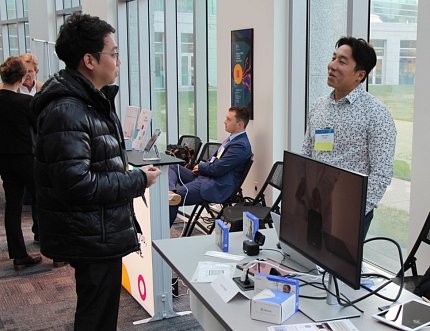Point-of-Care Tech Event Focuses on Partnerships, Speeding Translation

Photo: Raymond Macdougall/NIBIB
NIH recently hosted the first in-person conference for the Point-of-Care Technology Research Network (POCTRN) since the pandemic. Held at the Natcher Bldg., the meeting assembled under the theme “Research and Innovation Translation Partnerships in Point-of-Care Technologies.”
The network was established in 2007 by the National Institute of Biomedical Imaging and Bioengineering (NIBIB) and currently has several NIH institute partners that support six technology and research centers. Each center receives a five-year award to develop technologies with clinical applications using a network model that enhances complementary strengths and builds multidisciplinary partnerships.
The conference brought together more than 200 POCTRN researchers, technology developers, clinicians and industry partners, as well as regulatory administrators, leaders of non-governmental organizations and investor networks.
Highlights included two distinguished keynote speakers—new NIH Director Dr. Monica Bertagnolli and Dr. Renee Wegrzyn, director of the recently created Advanced Research Projects Agency for Health (ARPA-H).
Dr. Tiffani Lash, conference co-chair and program officer in NIBIB’s Division of Health Informatics Technologies, said the aim was to bring together key players to learn about available research resources, learn from recent successes and identify opportunities to develop collaborative research partnerships to accelerate the translation of point-of-care technologies.

Photo: Raymond Macdougall/NIBIB
Bertagnolli kicked off the event, commending POCTRN for the work that it did during the Covid-19 pandemic. She noted that the network established the Rapid Acceleration of Diagnostics (RADx) Tech program in record time and within months had products in people’s homes that they could use to test themselves.
Bertagnolli also said POCTRN plays a critical role in moving the promise of NIH research into people’s lives on multiple fronts.
“We can imagine a day when this network will be responsible for over-the-counter and point-of-care tests for many different conditions, including maternal health, fetal metabolic diseases, infections like hepatitis C and even neurological conditions,” she said. “We know that we’re not far off from seeing this resulting from your great work.”
She also pointed out that POCTRN, with its focus on technology and partnerships, fills a critical gap between scientific discoveries and the quality of care that patients receive.
NIBIB Director Dr. Bruce Tromberg picked up on the topic of translating research into clinical settings.
“At NIBIB,” he said, “we’re obsessed about data and the instrumentation producing it, aspects of standardization and how do we move ideas from the conceptual stage and benchtop into fully disseminated manufactured devices that impact public health.”

Photo: Raymond Macdougall/NIBIB
Three panels discussed point-of-care technology innovations from clinical, industry and regulatory perspectives. Other panels explored collaborative partnerships, technology translation, validation and business models for commercialization and translation in low-resource settings.
Panelists from POCTRN centers and industry discussed how they have used the point-of-care technology and lessons learned from the pandemic to solve other health problems in areas such as women’s health, nutrition, cardiovascular disease and heart, lung and blood disorders. Many of the innovations were presented during the rapid-pitch sessions and as exhibits in the technology showcase.
Participants also learned about available funding resources that could help move their innovations forward. This included an NIH preconference workshop featuring the Small Business Innovations Research program, and a forum highlighting both public and private sources of funding.
In her keynote talk, Wegrzyn described her agency’s mission as “accelerating better health outcomes for everyone. There’s a lot of great innovation in the world—we want to get it there faster—we measure progress as an agency by the impact we have on people’s lives.”
Wegrzyn also discussed some of the agency’s new initiatives and the shared goals of POCTRN and ARPA-H.
She said that her goal was to have in place before the next public health crisis the necessary infrastructure that NIH and other HHS entities could use. This includes a national clinical trial network that would advance clinical readiness.
“We believe 90% of all Americans should have access to a clinical trial within 30 minutes of their homes,” she said. “We’re looking for solvers to help us close that gap.”
